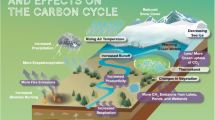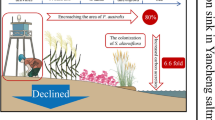Abstract
Nitrate leaching to streams is a sensitive indicator of the biogeochemical status of forest ecosystems. Two primary theories predicting long-term (decadal) changes in nitrate loss rates (N saturation theory and the nutrient retention hypothesis) both predict increasing dissolved inorganic nitrogen (DIN) losses for watershed 6 (W6), the biogeochemical reference watershed at the Hubbard Brook Experimental Forest (HBEF). Measured values, however, have declined substantially since measurements began in the mid-1960s. Are these theories wrong, or are there other important controls on DIN losses at the annual to decadal time scale that have obscured the tendency toward higher losses over time? We tested the individual and combined effects of several forms of disturbance on DIN loss rates from northern hardwood forests by comparing predictions from a relatively simple model of forest carbon, nitrogen, and water dynamics (PnET-CN) with the long-term record of annual DIN loss from W6 at HBEF. Perturbations tested include interannual climate variation, changes in atmospheric chemistry (CO2, O3, N deposition), and physical and biotic disturbances (two harvests, a hurricane salvage, and a defoliation event). No single disturbance caused changes in DIN losses to mimic measured values. Only when run with all of the disturbances combined did the model-predicted pattern of interannual change in DIN loss approach the measured record. Single-disturbance simulations allow an estimation of the role of each in the total pattern of DIN loss. We conclude that DIN losses from W6 were elevated in the 1960s by a combination of recovery from extreme drought and a significant defoliation event. N deposition alone, in the absence of other disturbances, would have increased DIN losses by 0.35 g N m−2y−1. These findings indicate that predictions of DIN losses must take into account the full spectrum of disturbance events and changes in environmental conditions impacting the systems examined.
Similar content being viewed by others
Author information
Authors and Affiliations
Additional information
Received 9 October 2001; Accepted 27 February 2002.
Rights and permissions
About this article
Cite this article
Aber, J., Ollinger, S., Driscoll, C. et al. Inorganic Nitrogen Losses from a Forested Ecosystem in Responseto Physical, Chemical, Biotic,and Climatic Perturbations. Ecosystems 5, 0648–0658 (2002). https://doi.org/10.1007/s10021-002-0203-8
Issue Date:
DOI: https://doi.org/10.1007/s10021-002-0203-8




